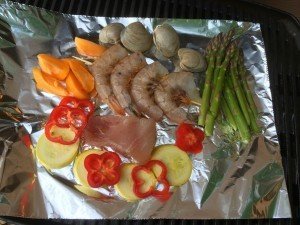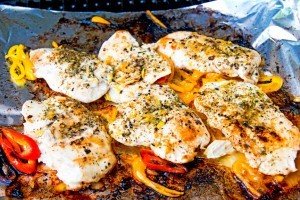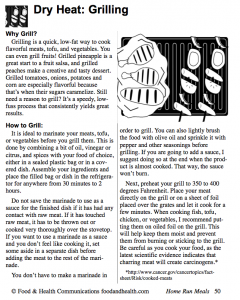A Beginner's Guide to Grilling
 The temperatures are continuing to rise, and in all this heat, who wants to turn on the oven or stove? Help your clients beat the heat with this fun guide to grilling. If you look really carefully, you'll even find a free handout that you can distribute as your own!Let's get started!Why Grill? Grilling is a quick, low-fat way to cook flavorful meats, tofu, and vegetables. You can even grill fruits! Grilled pineapple is a great start to a fruit salsa, and grilled peaches make a creative and tasty dessert. Grilled tomatoes, onions, potatoes, and corn are especially flavorful because that’s when their sugars caramelize. Still need a reason to grill? It’s a speedy, low-fuss process that consistently yields great results.How to Grill:It's ideal to marinate your meats, tofu, or vegetables before you grill them. This is done by combining a bit of oil with vinegar or citrus, along with some spices and your food of choice, either in a sealed plastic bag or in a covered dish. Assemble your ingredients and place the filled bag or dish in the refrigerator for anywhere from 30 minutes to 2 hours.Do not save the marinade to use as a sauce for the finished dish if it has had any contact with raw meat. If it has touched raw meat, it has to be thrown out or cooked very thoroughly over the stovetop. If you want to use a marinade as a sauce and you don’t feel like cooking it, set some aside in a separate dish before adding the meat to the rest of the marinade.
The temperatures are continuing to rise, and in all this heat, who wants to turn on the oven or stove? Help your clients beat the heat with this fun guide to grilling. If you look really carefully, you'll even find a free handout that you can distribute as your own!Let's get started!Why Grill? Grilling is a quick, low-fat way to cook flavorful meats, tofu, and vegetables. You can even grill fruits! Grilled pineapple is a great start to a fruit salsa, and grilled peaches make a creative and tasty dessert. Grilled tomatoes, onions, potatoes, and corn are especially flavorful because that’s when their sugars caramelize. Still need a reason to grill? It’s a speedy, low-fuss process that consistently yields great results.How to Grill:It's ideal to marinate your meats, tofu, or vegetables before you grill them. This is done by combining a bit of oil with vinegar or citrus, along with some spices and your food of choice, either in a sealed plastic bag or in a covered dish. Assemble your ingredients and place the filled bag or dish in the refrigerator for anywhere from 30 minutes to 2 hours.Do not save the marinade to use as a sauce for the finished dish if it has had any contact with raw meat. If it has touched raw meat, it has to be thrown out or cooked very thoroughly over the stovetop. If you want to use a marinade as a sauce and you don’t feel like cooking it, set some aside in a separate dish before adding the meat to the rest of the marinade. You don’t have to make a marinade in order to grill. You can also lightly brush the food with olive oil and sprinkle it with pepper and other seasonings before grilling. If you are going to add a sauce, I suggest doing so at the end when the product is almost cooked. That way, the sauce won’t burn.Next, preheat your grill to 350 to 400 degrees Fahrenheit. Place the meat directly on the grill or on a sheet of foil placed over the grates and let it cook for a few minutes. When cooking fish, tofu, chicken, or vegetables, I recommend putting them on oiled foil on the grill. This will help keep them moist and prevent them from burning or sticking to the grill. Be careful as you cook your food, as the latest scientific evidence indicates that charring meat will create carcinogens.*After you’ve placed the food on the grill or foil, allow it to cook about halfway. Carefully flip it over and then you can leave it there until you think it’s done. When grilling tofu, fruit, or vegetables, that’s it. When it’s done, go ahead and take it off the grill. For meat, fish, or poultry, you’ll need to take its temperature to double-check that it is safely cooked. The best test for poultry is to make sure it is firm in the center -- just like the palm of your hand. For fish, you can flake it with a fork to be sure the fish is done and not raw. For meat and ground meat, you can slice into it and make sure it’s not too pink. Once the meat reaches the safe temperature, then you can take it off the grill and let it rest for a few minutes before slicing and serving.Small vegetables are easiest to grill when you’ve threaded them onto skewers, tossed them in a grill basket, or placed them on oiled foil. Eggplant etc. can be cut into “steaks” and grilled like meat. Be sure to slice the vegetables into chunks or steaks that are roughly the same size. By the same token, group the veggies by cook time. Don’t thread zucchini onto the same skewers as whole red potatoes. If you do, you’ll find that when you’re done grilling, the zucchini will be mush and the potatoes could still be rock hard. Good skewer combos include a mixture of onions, bell peppers, zucchini, mushrooms, and summer squash, all grouped together or potatoes and sweet potatoes, also grouped together.Grilling Tips: For your health and to reduce flare-ups, trim the fat from your meat. Once you have used a plate and/or utensils to transport raw meat to the grill, get rid of them. Don’t ever use the same plate or utensils to transport your finished food. The juices from the raw meat can contaminate the cooked meat and cause food poisoning. Also, be aware that some grills have hot and cool areas. You can use these to your advantage and rotate items so they are done at the same time.Pan Grilling: No outdoor grill? No problem! Pan grilling is easy when you have a nonstick pan that has built-in ribbed grill markers. The ribs help give the food the right “look,” while also keeping everything raised out of fatty juices. You can buy a pan that sits on the stove or you can purchase an electric grill. A nonstick panini machine will also do the trick. To grill an item this way, heat the pan and place a lightly oiled piece of chicken or fish on the grill. Allow it to cook halfway and then turn it over and let it finish cooking. It is best to use medium-high heat so that you can cook the food evenly without burning the outside. You can also start an item on the stove and then finish it in the oven.This post is excerpted from Home Run Meals, a guide to healthful cooking that will please even the pickiest of eaters. With this book, every meal can be a home run! Get the details today.
You don’t have to make a marinade in order to grill. You can also lightly brush the food with olive oil and sprinkle it with pepper and other seasonings before grilling. If you are going to add a sauce, I suggest doing so at the end when the product is almost cooked. That way, the sauce won’t burn.Next, preheat your grill to 350 to 400 degrees Fahrenheit. Place the meat directly on the grill or on a sheet of foil placed over the grates and let it cook for a few minutes. When cooking fish, tofu, chicken, or vegetables, I recommend putting them on oiled foil on the grill. This will help keep them moist and prevent them from burning or sticking to the grill. Be careful as you cook your food, as the latest scientific evidence indicates that charring meat will create carcinogens.*After you’ve placed the food on the grill or foil, allow it to cook about halfway. Carefully flip it over and then you can leave it there until you think it’s done. When grilling tofu, fruit, or vegetables, that’s it. When it’s done, go ahead and take it off the grill. For meat, fish, or poultry, you’ll need to take its temperature to double-check that it is safely cooked. The best test for poultry is to make sure it is firm in the center -- just like the palm of your hand. For fish, you can flake it with a fork to be sure the fish is done and not raw. For meat and ground meat, you can slice into it and make sure it’s not too pink. Once the meat reaches the safe temperature, then you can take it off the grill and let it rest for a few minutes before slicing and serving.Small vegetables are easiest to grill when you’ve threaded them onto skewers, tossed them in a grill basket, or placed them on oiled foil. Eggplant etc. can be cut into “steaks” and grilled like meat. Be sure to slice the vegetables into chunks or steaks that are roughly the same size. By the same token, group the veggies by cook time. Don’t thread zucchini onto the same skewers as whole red potatoes. If you do, you’ll find that when you’re done grilling, the zucchini will be mush and the potatoes could still be rock hard. Good skewer combos include a mixture of onions, bell peppers, zucchini, mushrooms, and summer squash, all grouped together or potatoes and sweet potatoes, also grouped together.Grilling Tips: For your health and to reduce flare-ups, trim the fat from your meat. Once you have used a plate and/or utensils to transport raw meat to the grill, get rid of them. Don’t ever use the same plate or utensils to transport your finished food. The juices from the raw meat can contaminate the cooked meat and cause food poisoning. Also, be aware that some grills have hot and cool areas. You can use these to your advantage and rotate items so they are done at the same time.Pan Grilling: No outdoor grill? No problem! Pan grilling is easy when you have a nonstick pan that has built-in ribbed grill markers. The ribs help give the food the right “look,” while also keeping everything raised out of fatty juices. You can buy a pan that sits on the stove or you can purchase an electric grill. A nonstick panini machine will also do the trick. To grill an item this way, heat the pan and place a lightly oiled piece of chicken or fish on the grill. Allow it to cook halfway and then turn it over and let it finish cooking. It is best to use medium-high heat so that you can cook the food evenly without burning the outside. You can also start an item on the stove and then finish it in the oven.This post is excerpted from Home Run Meals, a guide to healthful cooking that will please even the pickiest of eaters. With this book, every meal can be a home run! Get the details today.

 Thanks for scrolling! Here's a free copy of the grilling handout, just for you. Get it now.
Thanks for scrolling! Here's a free copy of the grilling handout, just for you. Get it now. *http://www.cancer.gov/cancertopics/factsheet/Risk/cooked-meats
*http://www.cancer.gov/cancertopics/factsheet/Risk/cooked-meats
